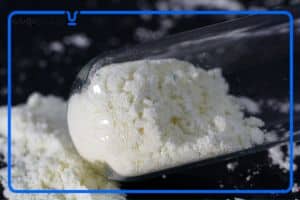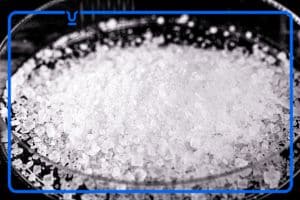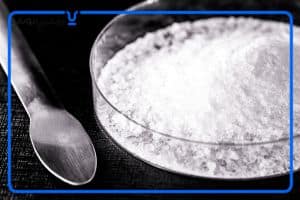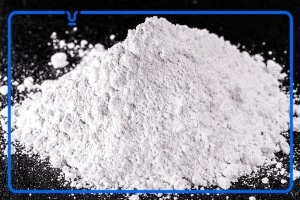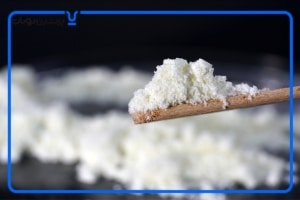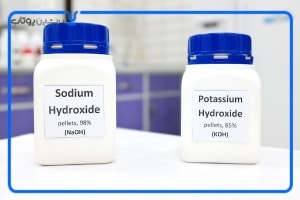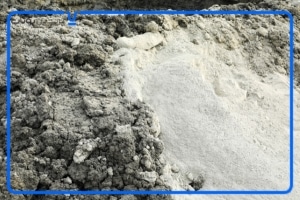POTASSIUM HYDROXIDE
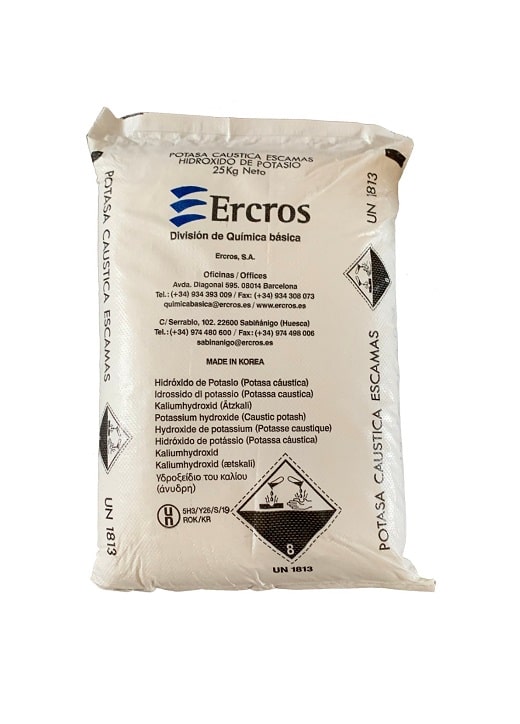
Product Information
CAS Number:
1310-58-3
Chemical and physical data
Formula : KOH
Molar Mass: 56.1056 g·mol−1
Density : 2.044 g/cm3
Melting point : 1327 °C
Boiling point : 553 °C
Other Names
Lye
Wine Tank Cleaner K
Koh
Potassium Hydroxide
Caustic Potash
Potassium hydrate
Caustic Potash Liquid ** DO NOT USE **
Caustic Potash Liquid
What is Potassium Hydroxide?
Potassium hydroxide is a chemical that exists in powder, flake, or pellet form. Commonly known as licking or potash. It is a caustic chemical. Potassium hydroxide solution is a strong mineral liquid that acts as a strong base. This solution has many uses. Chlorine and hydrogen are used during the process of producing potassium hydroxide.
History of potassium and potassium hydroxide
Until the 18th century, there was no distinction between potassium and sodium. This was because early chemists did not recognize that mineral alkalis (from earth's sediments, sodium carbonate) and plant alkalis (derived from chulch ash, potassium carbonate) were distinct from each other. But eventually this distinction happened. Before potassium was recognized as an element, a mixture of potassium carbonate and animal fat was used to make soap. Potassium was isolated in 1807 by Sir Humphrey Davy, and potassium hydroxide was obtained by electrolysis of potash. Potassium is collected from the cathode, and is also the first metal to be separated by electrolysis.
Structure and formula of potassium hydroxide
The chemical formula of potassium hydroxide is KOH. The structure of KOH consists of an ionic bond between anion and a hydroxyl cation.
Different degrees of potassium hydroxide
45% potassium hydroxide
50% potassium hydroxide
Physical features
Potassium hydroxide is a white solid with a density of 2,044 g / ml, a melting point of 360 ° C and a boiling point of 1,327. It is usually available as clear pellets or aqueous solutions of various concentrations.
Chemical properties
Potassium hydroxide is a highly moist solid that absorbs water from the air, making it a useful laboratory desiccant. It is thermally stable (does not decompose even at high temperatures). This substance dissolves in water and a highly alkaline aqueous solutions are formed called potassium sludge. It reacts easily with acids to form potassium salts that have many applications in industry.
PH of potassium hydroxide
KOH is an example of a strong base, you can use this compound as 100% split into hydroxide ions in solution. This means that it dissolves into its ions in aqueous solution. Although the pH of KOH or potassium hydroxide is very high (usually between 10 and 13 in normal solutions), its exact value depends on the concentration of this strong base in water. Therefore, it is important to know how to calculate the p.
Strong base pH
Potassium hydroxide is a strong base in terms of chemical ionization, and its solutions can be measured using a strong acid such as hydrochloric acid or sulfuric acid or using an acidic standard such as potassium hydrogen phthalate (KHP). Typical neutralization reactions include: KOH + HCl → KCl + H 2 O KOH + KHPhthalate → K 2 phthalates + H 2 O The end point can be determined using a number of pH indicators by changing the color at any point in the pH range 3 - 10.5.
The choice of index used depends on the initial concentration of potassium hydroxide and the strength of the acid used. This is because acid and base habits affect the shape of the neutralization curve that results during titration. When both the acid and the base are normal in concentration 1, indicators with an effective range between pH 3 and 10.5 can be used. Suitable indicators include methyl orange, green bromocrozole, methyl red, methyl purple, blue bromothymol, red phenol, phenolphthalein and thymolphelalin. When both acid and base are normal, the ideal pH range is reduced to 4.5 to 9.5. Therefore, methyl orange and thymolphelaine are not as suitable as others. With 0.01 g of normal solution, the ideal pH range is further limited to 5.5 - 8.5.
Potassium hydroxide problems on the skin
At high concentrations, potassium hydroxide can aggravate the skin, even if used in washing products such as soaps or cleansers. In fact, using an alkaline cleanser, even once, can cause significant damage to the skin.
Alkaline cleansers alter the composition of the skin's natural bacterial flora and the activity of enzymes in the upper layers of the skin, because these two have optimal pH levels. In addition, the damage is cumulative. The longer you use the product, the more damage it will do to your skin.
Health effects / safety hazards
Potassium hydroxide is a strong base that can penetrate the skin and tissues. Skin and eye contact with KOH solution can cause burns, severe irritation and even blindness. Inhalation of this substance also damages the mucous membranes and lungs. KOH solution is very toxic and deadly if swallowed and can lead to permanent tissue damage.
Challenges of potassium hydroxide
When potassium hydroxide is dissolved in water or neutralized with acid, it releases a significant amount of heat. If not done properly, it can cause a severe, exothermic reaction that ignites flammable materials.
Uses of potassium hydroxide or potassium hydroxide
Chemical is a major industry that is used as a base in a wide range of chemical processes.
The most used in the production of potassium carbonate, potassium phosphates, liquid fertilizers and soaps and detergents are potassium. The largest single use is in the production of potassium carbonate, which is mainly used in the manufacture of special glasses, including television tubes.
Potassium hydroxide is used in agriculture to modify the pH of acidic soils. It can also be used as a fungicide or even herbicide. Used in the production of agricultural fertilizers. These fertilizers can be used as a source of potassium (one of the three main plant foods) for products that are sensitive to chloride ions.
Used as a substitute for caustic soda in the production of biodiesel.
Some applications of KOH include acrylate ester copolymer coating, anti-foaming agents in paper making, liquid soap making oils, food formulations, pH control agent, polyethylene resins, textile processing and as a catalyst in reactions such as Biodiesel production.
Other uses in veterinary medicine are in separating calf horns and dissolving scales and hair. In human medicine, it is used to diagnose fungal infections and as a wart and cuticle solvent and to make cleansers. These compounds are also used in toothpastes, some dentures, non-phosphates, and drain or tube cleaners.
A very significant use of potassium hydroxide, in terms of importance in alkaline batteries use aqueous solution of KOH as an electrolyte. Therefore, potassium hydroxide helps power flashlights, smoke detectors, and other battery-powered appliances.
It is also an anisotropic silicon pen that exposes octagonal plates. This method can create etches on a regular basis for applications such as micro-electromechanical systems, pyramids and holes.
The final applications of potassium hydroxide or potassium hydroxide include plating, herbicides, greases, catalysts, oxidizers, drugs and alkaline-electrolytic batteries. Potassium hydroxide is used as a direct intermediate for several potassium chemicals, including potassium cyanide, aluminate, formate, flosilica, borohydride, bromate, bromide, gluconate, lorate, manganese, oleate, and titanate.
Potassium hydroxide storage
If you need to store potassium hydroxide in situations, know that this chemical requires special storage.
The storage and use of potassium hydroxide requires a chemical reservoir system that matches the hardness of a hazardous substance, and in the event of a leak, there is the possibility of catastrophic failure. A cross-linked polyethylene tank with a rotating mold is ideal for this. These tanks usually consist of two layers, ie the tank is in the tank and has a lot of safety.
Having the right storage method will give you peace of mind that there will be no unexpected accidents or crashes.
Also, be sure to consider a secondary restraint system when evaluating your storage options. Because of the potential risks, secondary containment is an absolute environmental and safety priority.
To store potassium hydroxide safely, keep it in a cool, dry place.
The role of potassium hydroxide in biofuel
Using potassium hydroxide to make biofuel is a method that dissolves triglycerides (fats) and allows the alcohol to bond with the resulting fatty acids. This is a process called transesterification that converts fats and oils into biodiesel and glycerin. Simply put, the raw material is a short-chain alcohol. Methanol is the most commonly used alcohol because it is cheap, although ethanol is also popular, and butanol and amylic alcohol are also viable starting materials. For example, about 10 liters of alcohol is mixed slowly with potassium hydroxide as a catalyst, and it must be ensured that the alcohol is pure with all water removed to improve the efficiency of the subsequent chemical reaction. 100 liters of oil is added to this alcohol-catalyst mixture (most biofuels are produced from vegetable oil). The resulting chemical reaction converts esters (oils and fats) into a mixture of fatty acid esters that make up oil (or fat). The alcohol then purifies the fatty acids into a biodiesel. Reducing the amount of carbon produced by the transportation sector will not be easy, but with the help of biodiesel and potassium hydroxide, which play a role in making this change, it is very possible.
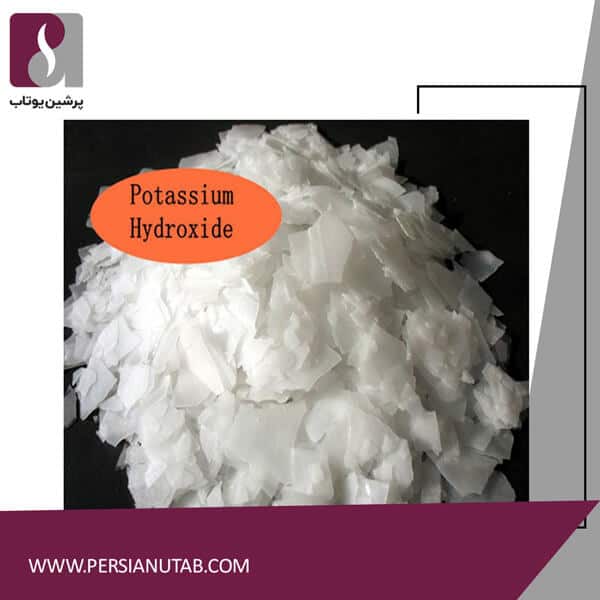
Applications of potassium hydroxide
Potassium hydroxide solution has many applications in various industries. From food and skin care products and medicines to agriculture and glass production. Electrolyte is also used in the manufacture of batteries and some airport runways. In addition, KOH is used in the manufacture of skin care products such as body lotions, soaps and shampoos. Potassium hydroxide is also used in liquid fertilizer due to its high solubility and low salt content.
Potassium hydroxide as a cleanser
Potassium hydroxide is a very diverse cleaning agent. For example, potassium hydroxide is found in a variety of items such as liquid soaps, lotions, shampoos, sprays, and dentures. It is mostly used in industrial compounds such as stove cleaners, drain cleaners, road and concrete cleaners, detergents and in drain and pipe cleaners.
While the use of sodium hydroxide for soap is common, potassium hydroxide soaps are actually more soluble in water and better for the environment. Potassium hydroxide soaps are also known as "soft soaps". Although not as popular as sodium soaps, potassium soaps are produced in varying concentrations of liquid and are often used in combination with sodium soaps, for example in shaving products as well as in the textile industry.
Potassium hydroxide as a pH regulator
Potassium hydroxide is a strong alkali or base, and many uses are the result of this property. It acts as a base, pH regulator in industrial manufacturing and processing. Potassium hydroxide is used in agriculture to regulate the pH of acidic soils.
Potassium hydroxide in medicine
It also has medicinal uses. In veterinary medicine, potassium hydroxide is used to separate calves' horns and to dissolve scales and hair. In humans, it can be used to diagnose fungal infections. It can also be used to dissolve warts and cuticles.
Potassium hydroxide in food
Potassium hydroxide is often found as an additive in commercial processed foods and as a detergent or chemical peel for fruits and vegetables. It is added to processed foods as a stabilizer to increase shelf life and as a thickener. It is involved in the processing of chocolate and cocoa, the processing of soft drinks and the thickening of ice cream. Potassium hydroxide is used to soften olives and glaze salt wood before cooking to make them crispy.
Superficial fungal infections have a high prevalence worldwide. Dermatophytosis is the most common and important skin fungal infection. Because of the need for long-term antifungal therapy, an accurate diagnosis of dermatophytosis is essential before starting treatment. Cultivation of other material mushrooms is relatively expensive and costly. Potassium hydroxide is a gold standard for diagnosis and testing
It is dermatophytosis, and the test with potassium hydroxide is simple, quick and cheap, and no fungal culture is needed to diagnose superficial fungal infections, especially dermatophytes, due to the high sensitivity of the KOH test.
Potassium hydroxide solution
Potassium hydroxide solutions, both aqueous and alcoholic, up to 50% strength are used for various purposes, but for use as a detergent, 5% aqueous solution is generally useful. 0.3% potash solution may be used to dissolve alluron seeds. A 5% solution is much more powerful and quickly dissolves starch, protein, etc. and causes cell wall swelling. Potash should be washed as soon as cleaning is completed, as prolonged activity may cause decomposition.
Potassium hydroxide production process
Previously, by adding potassium carbonate (potash) to a strong solution of calcium hydroxide (molten lime), potassium hydroxide was made, which led to a metatase reaction, precipitating calcium carbonate, and potassium hydroxide remaining in the solution:
Ca (OH) 2 + K 2 CO 3 → CaCO 3 + 2 KOH
Filtration of precipitated calcium carbonate and boiling of the solution causes potassium hydroxide. This was the most important method of producing potassium hydroxide until the late nineteenth century, which was largely replaced by the current method of electrolysis of potassium chloride solutions. This method is similar to the production of sodium hydroxide.
2 KCl + 2 H 2 O → 2 KOH + Cl 2 + H 2
Hydrogen gas is formed as a by-product on the cathode. Simultaneously, anodic oxidation of the chloride ion occurs, forming chlorine gas as a by-product. Separation of anodic and cathodic spaces in the electrolysis cell is essential for this process.
Miscellaneous applications of potassium hydroxide
Potassium hydroxide acts as a foaming agent in the paper production process. Potash is an excellent pH regulator and is therefore used on farms to regulate the pH balance of acidic soils. It is also used as a grass food, industrial fertilizer, fungicide and herbicide. Heated potassium hydroxide is commonly used for mass etching of silicon wafers, which is important in the manufacture of some microelectronic devices.
Potassium hydroxide solutions
Potassium hydroxide solutions corrode aluminum and its alloys due to the formation of hydrogen gas. This corrosion can be prevented by adding potassium salts related to acids.
In corrosion behavior and safety requirements, potassium hydroxide is very similar to sodium hydroxide (NaOH). Although potassium hydroxide is slightly more aggressive, it is generally associated with a higher boiling point and the possibility of exposure to higher temperatures.
Nickel alloys in sodium hydroxide are less sensitive to stress cracking in potassium hydroxide. Plastics and coatings show the same resistance to potassium hydroxide and sodium hydroxide, except for fiberglass-reinforced plastics, which are less resistant to potassium hydroxide, regardless of the type of resin used.
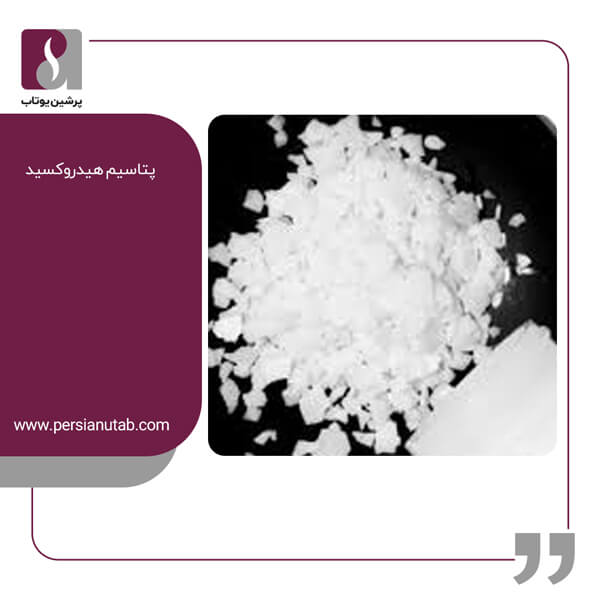
Most people use this solution in their daily lives. For example (from batteries to fertilizers and soaps). It helps to neutralize acid as a strong base, it can also be used as a thickener and food stabilizer. Potassium hydroxide has medicinal properties for both humans and animals and represents many industrial processes.
Similarities and differences between potassium hydroxide and sodium hydroxide
Potassium hydroxide and sodium hydroxide are remarkably similar and can often be used in the same applications. In soap making, they are used in the process of converting fats into soap. Likewise, both compounds can be used to make biodiesel. However, despite their similarities, there are a few cases in which you can not exchange one for another. For example, potassium hydroxide is used as an electrolyte in alkaline batteries and sodium hydroxide in water treatment.Of all the compounds in the hydroxide group, potassium hydroxide and sodium hydroxide are the most chemically similar. Chemical reactions are completely consistent with the physical appearance of solids and liquids and their behavior, allowing them to stand together in different situations.Their differences start at the molecular level. Potassium hydroxide is slightly smaller than sodium hydroxide, meaning it transports oil molecules faster than sodium hydroxide.This makes potassium hydroxide a good choice for soaps that need to remove cake oil. It also releases slightly less heat than sodium hydroxide when exposed to water.The world consumes 700,000 to 800,000 tons of the compound annually.
Potash trade
Global potash production in 2018 was estimated at 68.1 million tons. Canada is the largest producer of potash in the world, accounting for 33% of the total world in 2018. It is the largest exporter of potash in the world. In 2018, Canada exported 21.9 million tonnes of potash, accounting for 41% of world total exports. Four countries (Canada, Belarus, Russia and China) account for 80% of world potash production in 2018. In general, the price of potash was declining from 2012 to the first half of 2017. Prices began to rise in the second half of 2017.
Daily price of potassium hydroxide
For the daily price of potassium hydroxide, the average weight of weighted transactions with volume including contractual and transactional transactions in the specified locations.The global market for caustic soda has reached about 2.6 million tons in 2019 due to the growing demand of the final consumption sectors. It is predicted to see more growth and 4.5% CAGR growth in the forecast period 2020-2025. The global market for caustic potash is expected to be driven by the increasing use of this product in the food and personal care industries, reaching 3.4 million tons by 2025.With forms, the global market for caustic potash is divided into solid and liquid. Grading types of this product include industrial, reagent and pharmaceutical. Based on end use, the market can be divided into potassium carbonate, potassium phosphates, potassium soaps and detergents, liquid fertilizers and agricultural chemicals. The major regional markets for this product are North America, Europe, Asia Pacific, Latin America, the Middle East and Africa.The main application of potassium hydroxide (about 75%) is potassium carbonate, which is used to make glass for cathode ray tubes used in televisions and computer monitors. This sector has grown by 5% annually in recent years, but with the soft economy and the introduction of flat panel displays, the growth has reached about 2.5%.
Chemical reactions performed with potassium hydroxide
Esther soap making
The ester is soaped by heating a certain amount of potassium hydroxide in an organic solvent in a sealed tube. For this reaction to be analytically useful, it must be within a reasonable amount of time. One of the conditions that helps to react quickly and quantitatively is to use a strong base as much as possible.
KOH + RCOOR' → RCOOK + R'OH
Potassium hydroxide reacts with CO 2 to produce bicarbonate.
Adding potassium hydroxide ions to lime regulates the pH, because potassium hydroxide ions react with carbon dioxide to form an bicarbonate alkali.
KOH + CO 2 → KHCO 3
Buy and sell high quality potassium hydroxide
Are you looking for an ideal manufacturer and supplier of high quality potassium hydroxide? We have a wide selection at a great price to help you.Our pure potassium hydroxide is used in high quality applications which is the main quality and is produced according to good methods.The compatibility and low impurity level of pure chemical alkalis make us a reliable partner in the pharmaceutical, cosmetic, food and laboratory industries.
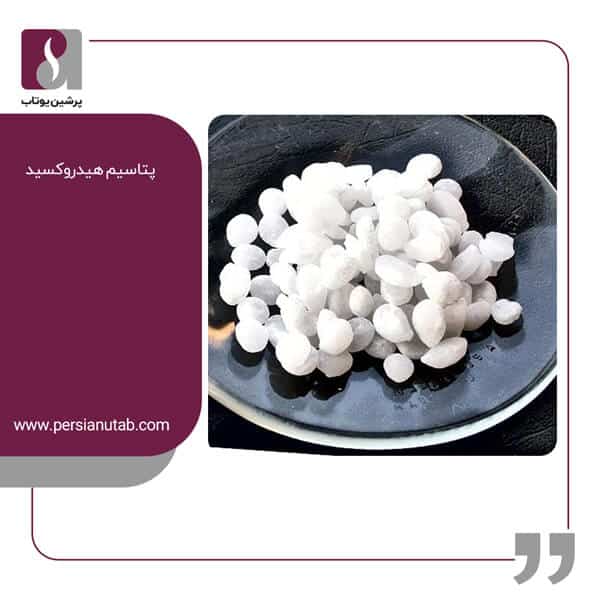
Our highly alkaline pellets are used in the production of cosmetics for soap making, cleaning and pH adjustment.We provide the best quality potassium hydroxide blooms. In the form of white shells that are best used for the food industry.This product can be prepared as is or diluted with water in a certain concentration. It can be prepared in bulk or packaged and labeled if needed.Potassium hydroxide, 45%, has a very low freezing point and can be used to maintain alkalinity in water-based drilling fluids used in freeze-thaw environments.
PersianUtab is a supplier and distributor of food and non-food, pharmaceutical, health and detergent industries. The company offers a wide range of potassium hydroxide products in collaboration with leading manufacturers. Our products come in a variety of sizes, grades and configurations for use in many industrial applications. You can be sure of buying bulk and economical potassium hydroxide in PersianUtab. Buy this product with excellent quality.Read this article to Whole sale and cost-effective purchase of potassium hydroxide in PersianUtab
Experience the Sell potassium hydroxide at a reasonable price at a reasonable in PersianUtab. PersianUtab Company specializes in various fields, including the sale of chemicals, and with years of experience in selling a variety of chemicals from the health industry to food. Ask us to sell potassium hydroxide at a reasonable price and the highest quality food. If you want to buy from us, contact our sales experts and order your product. Potassium hydroxide is obtained by electrolytic process, is available in solution from 45% to 50% and in solid form with 92% purity shells.One of the ways potash traders trade through commercial companies is in extracting and refining potash. Farmers around the world use potash and make futures deals for potash this is a Sell potassium hydroxide at a reasonable price.
Solid potassium hydroxide
Solid potassium hydroxide is used as an intermediate in a wide range of production processes, from the production of drugs and fertilizers, to its use in oil refining. In addition, it is a precursor to other potassium compounds.
Potassium hydroxide is a solid with high humidity, meaning that it absorbs and retains water molecules from the environment, making it a useful laboratory desiccant. This type of potassium hydroxide is used to make solvents for degreasing and cleaning, lubricating additives, corrosion inhibitors, and other potassium-based salts. In food industry applications, solid KOH acts as an acidity regulator and as an inhibitor for the production of potassium sorbate and other food preservatives.
Relationship between potassium hydroxide and sulfuric acid
Potassium hydroxide and sulfuric acid are different in many ways. One is a liquid acid and the other is a solid base. However, when they are mixed, they form two useful compounds, water and potassium sulfate, which are safer than their main constituents. Two hydrogen atoms, one sulfur atom and four oxygen atoms contain sulfuric acid, which is a major part of many other chemical reactions.
Sulfuric acid is very effective in separating itself and other chemicals to form new chemicals. Potassium hydroxide, potassium atoms, oxygen and hydrogen are made. The chemical reaction of sulfuric acid and potassium hydroxide is known as acid and base neutralization. In this type of reaction, acid and base mix together to form water and salt, though not necessarily table salt.
Sulfuric acid and potassium hydroxide salts produce potassium sulfate. Two molecules of potassium hydroxide combine with one sulfuric acid atom. Two atoms of potassium move to the sulfate ion, which is a charged particle consisting of a sulfur atom attached to four oxygen atoms of sulfuric acid, and two hydrogen atoms of the acid molecule to combine with two oxygen atoms and two hydrogens. The remaining atoms of potassium hydroxide ions are used to make two molecules of water.
When sulfuric acid and potassium hydroxide are combined, the reaction products of both are much safer than the input. water is a useful compound that is neither corrosive nor toxic and Potassium sulfate is one of the most popular fertilizers in the world.
To inquire about the price of potassium hydroxide and order the purchase of this product, you can contact the sales experts of potassium hydroxide of Persian YouTube company.

